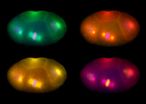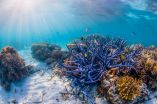(Press-News.org) SAN FRANCISCO--The Pacific and North America plate boundary off the coast of British Columbia and southeastern Alaska is a complex system of faults capable of producing very large earthquakes. The recent 2012 Mw 7.8 Haida Gwaii and 2013 Mw 7.5 Craig earthquakes released strain built up over years, but did not release strain along the Queen Charlotte Fault, which remains the likely source of a future large earthquake, according to reports published in a special issue of the Bulletin of the Seismological Society of America (BSSA).
"The study of these two quakes revealed rich details about the interaction between the Pacific and North America Plates, advancing our understanding of the seismic hazard for the region," said Thomas James, research scientist at Geological Survey of Canada and one of the guest editors of the special issue, which includes 19 technical articles on both the Haida Gwaii and Craig events.
The Haida Gwaii and Craig earthquakes offered new information about the tectonic complexity of the region. Prior to the 2012 earthquake, the Queen Charlotte Fault, a strike-slip fault similar to the San Andreas Fault in California, was the dominating tectonic structure in the area.
Nykolaishen et al. used GPS observations of crustal motion to locate the earthquake's rupture offshore to the west of Haida Gwaii, rather than beneath the islands. A close study of the Haida Gwaii mainshock by Kao et al. revealed the Pacific plate slid at a low angle below the North American plate on a previously suspected thrust fault, confirming the presence of subduction activity in the area.
"This was an event the thrust interface of the plate boundary system, confirming that there is a subduction system in the Haida Gwaii area," said Honn Kao, seismologist with the Geological Survey of Canada, who, along with his colleagues, examined the source parameters--causative faults, rupture processes and depths--of the mainshock and sequence of strong aftershocks.
"The implication of a confirmed subduction zone is that in addition to the Queen Charlotte Fault, we now have another source which can produce devastating megathrust earthquakes in the area," said Kao.
The aftershocks clustered around the periphery of the rupture zone, both on the seaward and landward side of the plate boundary and reflected normal faulting behavior--caused by the bending, extending or stretching of rock-- rather than the thrust faulting of the mainshock.
"Our observations of normal faulting imply that the mainshock of the Haida Gwaii earthquake dramatically altered the stress field in the rupture zone, especially in a neighboring region," said Kao.
The distribution of aftershocks occurred to the north of a previously identified seismic gap where large earthquakes have not occurred in historic times. The gap is located to the south of the where 1949 M8.1 Queen Charlotte earthquake ruptured. Though the Haida Gwaii earthquake may have activated some part of the Queen Charlotte Fault, said Kao, it was limited and did not relieve stress along the seismic gap.
The Haida Gwaii rupture shook southeastern Alaska, and the northwest directivity of ground motion may have influenced the timing of the January 2013 Craig earthquake, suggests James et al. in the introduction to the overall special issue.
A report by Stephen Holtkamp and Natalia Ruppert at the University of Alaska Fairbanks examines 1785 aftershocks in the Craig earthquake sequence, identifying a mix of faulting behavior that suggests the region is still in a state of transpression--the plates are both sliding past each other and colliding at an angle.
The articles in this special issue will appear in print in early May and online in April. The special issue features three main themes. The regional tectonic framework and the nature of the interaction between the Pacific and North America plates at the Queen Charlotte Fault zone are presented in five papers. Three papers focus on the Craig earthquake and examine the main shock, aftershocks and crustal motions. Ten papers discuss the Haida Gwaii event.
INFORMATION:
The following papers will appear online April 7:
Introduction to the Special Issue, Thomas James, John Cassidy, Garry Rogers, and Peter Haeussler
Source Characteristics of the 2012 Haida Gwaii Earthquake Sequence, Honn Kao, Shao-Ju Shan, and Amir Farahbod
A High Resolution Aftershock Catalog of the Magnitude 7.5 Craig, Alaska Earthquake on 5 January 2013, Stephen Holtkamp and Natalia Ruppert
GPS Observations of Crustal Deformation Associated with the Mw 7.8 2012 Haida Gwaii Earthquake, Lisa Nykolaishen, Herb Dragert, Kelin Wang, Thomas James, and Michael Schmidt
Massachusetts General Hospital (MGH) investigators have identified an inflammatory molecule that appears to play an essential role in the autoimmune disorder systemic lupus erythematosus, commonly known as lupus. In their report being published online in Nature Immunology, the researchers describe finding that a protein that regulates certain cells in the innate immune system - the body's first line of defense against infection - activates a molecular pathway known to be associated with lupus and that the protein's activity is required for the development of lupus symptoms ...
MIT researchers have developed a new, ultrasensitive magnetic-field detector that is 1,000 times more energy-efficient than its predecessors. It could lead to miniaturized, battery-powered devices for medical and materials imaging, contraband detection, and even geological exploration.
Magnetic-field detectors, or magnetometers, are already used for all those applications. But existing technologies have drawbacks: Some rely on gas-filled chambers; others work only in narrow frequency bands, limiting their utility.
Synthetic diamonds with nitrogen vacancies (NVs) -- ...
Dividing cells--whether they're in an embryo or an adult--rely on the right processes happening at the right time to turn out healthy.
Now, researchers at the University of Iowa have identified a mechanism that dividing cells in worms use to ensure their proper development, and they believe the same process could be going on in humans. The mechanism, unknown until now, describes one part of the cell, called the centrosome, as an "internal timekeeper"--like a train conductor. A crucial protein in charge of gene expression, beta-catenin, is described as a "hitchhiker"--it ...
Physical activity that makes you puff and sweat is key to avoiding an early death, a large Australian study of middle-aged and older adults has found.
The researchers followed 204,542 people for more than six years, and compared those who engaged in only moderate activity (such as gentle swimming, social tennis, or household chores) with those who included at least some vigorous activity (such as jogging, aerobics or competitive tennis).
They found that the risk of mortality for those who included some vigorous activity was 9 to 13 per cent lower, compared with those ...
Leading coral reef scientists say Australia could restore the Great Barrier Reef to its former glory through better policies that focus on science, protection and conservation.
In a paper published in the journal Nature Climate Change, the authors argue that all the stressors on the Reef need to be reduced for it to recover.
An Australian Government report into the state of the Great Barrier Reef found that its condition in 2014 was "poor and expected to further deteriorate in the future". In the past 40 years, the Reef has lost more than half of its coral cover and ...
Many nursing home residents who underwent lower extremity revascularization died, did not walk or had functional decline following the procedure, which is commonly used to treat leg pain caused by peripheral arterial disease, wounds that will not heal or worsening gangrene, according to an article published online by JAMA Internal Medicine.
Lower extremity revascularization is often performed so patients with peripheral arterial disease can maintain the ability to walk, which is a key component of functional independence. But outcomes among patients with high levels of ...
Quality of life was good and cognitive function was similar in patients with cardiac arrest who received targeted body-temperature management as a neuroprotective measure in intensive care units in Europe and Australia, according to an article published online by JAMA Neurology.
Brain injury is the primary cause of death for patients treated in intensive care units after suffering cardiac arrest (CA) outside of a hospital. Targeted temperature management (TTM) has been implemented as a neuroprotective treatment for comatose CA survivors because of reports of improved ...
Application of pediatric guidelines for lipid levels for persons 17 to 21 years of age who have elevated low-density lipoprotein cholesterol (LDL-C) levels would result in statin treatment for more than 400,000 additional young people than the adult guidelines, according to an article published online by JAMA Pediatrics.
Adolescence is a common time for the emergence of risk factors for cardiovascular disease, including abnormal cholesterol levels. The 2011 National Heart, Lung, and Blood Institute Integrated Guidelines for Cardiovascular Health and Risk Reduction in ...
Only a few U.S. nursing home residents who undergo lower extremity revascularization procedures are alive and ambulatory a year after surgery, according to UCSF researchers, and most patients still alive gained little, if any, function.
The study appears in the April 6 issue of JAMA Internal Medicine.
"Our findings can inform conversations among physicians, patients and families about the risks and expected outcomes of surgery and whether the surgery is likely to allow patients to achieve their treatment goals," said senior author Emily Finlayson, MD, MS, associate ...
Seventy per cent of glacier ice in British Columbia and Alberta could disappear by the end of the 21st century, creating major problems for local ecosystems, power supplies, and water quality, according to a new study by University of British Columbia researchers.
The study found that while warming temperatures are threatening glaciers in Western Canada, not all glaciers are retreating at the same rate. The Rocky Mountains, in the drier interior, could lose up to 90 per cent of its glaciers. The wetter coastal mountains in northwestern B.C. are only expected to lose about ...

